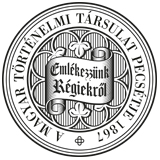Századok – 2010
KÖZLEMÉNYEK - Weisz Boglárka: Vásárok a középkorban
VÁSÁROK A KÖZÉPKORBAN 1453 - (sokadalom, szept. 27.) — 1387: Bánffy Oki. I. 411. Varannó [Vranov nad Topl'ou, H] (hétfő) — 1350: CD IX/1. 769. Vásárhely [Trhoviste (Vásárd), SVK] (hetivásár) — 1220: VáRO Reg. 276. sz. Zemplén [Zemplín, SVK] (szombat) — 1415: ZsO V. 1342. sz. Zólyom megye Besztercebánya [Banská Bystrica, SVK] (hetivásár) — 1480: DF 271 829. ~ (sokadalom) — 1480: DF 271 829. Breznóbánya [Brezno, SVK] (szombat) — 1488: DL 30 856. ~ (sokadalom, aug. 15.) — 1488: DL 30 856. Korpona [Krupina, SVK] (hetivásár) — 1265: VMMS 49. - (hétfő) — 1409: ZsO II/2. 6725. sz. - (kedd) — 1409: ZsO II/2. 6725. sz. - (sokadalom, Ascensio D.) — 1393: Csery J.: Korpona 129. (2. sz. jegyz ). - (sokadalom, szept. 29.) — 1393: Csery J.: Korpona 129. (2. sz. jegyz ). ~ (sokadalom, jún. 29.) — 1510: DF 274 517. - (sokadalom, febr. 6.) — 1510: DF 274 517. Zólyom [Zvolen, SVK] (hetivásár) — 1416: ZsO V. 2049. - (sokadalom, aug. 15.) — 1390: DF 268 911. - (sokadalom, szept. 21.) — 1412: ZsO III. 1970. sz. - (sokadalom, szept. 8.) — 1495: DF 268 945. ~ (sokadalom, nov. 19.) — 1495: DF 268 945. ~ (sokadalom, febr. 24.) — 1495: DF 268 945. FAIRS AND MARKETS IN THE MIDDLE AGES by Boglárka Weisz (Summary) In terms of frequency, three kinds of market/fair can be distinguished in the Middle Ages upon the basis of oui - source material: daily, weekly and annual markets. Weekly markets (forum ebdomadale seu septimanale) were also referred to as forum sollempne, forum generale, forum commune, or forum publicum. Annual fairs (forum annuum) were also called forum annuale, nundinae, congregatio, or feria in the Latin sources, whereas German texts refer to them as Jahrmarkt. As for forum cottidianum, we need not understand it as a market in the strict sense of the word, for in localities which boasted the staple right it designated not a daily market but was used as a general term of wholesale trade independently of markets. Of course, this does not mean that in these localities there were no small-scale markets, offering especially foodstuffs (fragnermarkt), where one would find market-women and other minor retailers among the sellers. In the early 11th century markets were held on Sunday in front of the church, but at the end of the century it was already forbidden. In the course the 12t h and 13t h centuries markets could be held on any day from Monday to Saturday, whereas from the second half of the 14t h centuiy Sunday markets were authorised again. The day of the market rarely changed in the course of time, but the number of market days could increase, so that a given locality could have two or even three market days a week. They frequently took place at different points within the same locality, and the person holding the market could vary as well. Annual fairs could be held in any month of the year, stable and moveable feasts could equally serve as their fixed point. It can be observed that the time of the annual fair was frequently fixed for the feast of the patron saint or for the day on which the local church was consecrated. Any given locality could obtain the privilege of holding more than one fair, either by providing for an annual gathering alongside the one which existed already, or by securing a privilege which allowed the holding of several fairs. Two basic features of the forum liberum in the Árpád age can be established on the basis of our sources. Before all, the ruler guaranteed the free movement of people arriving to and leaving
